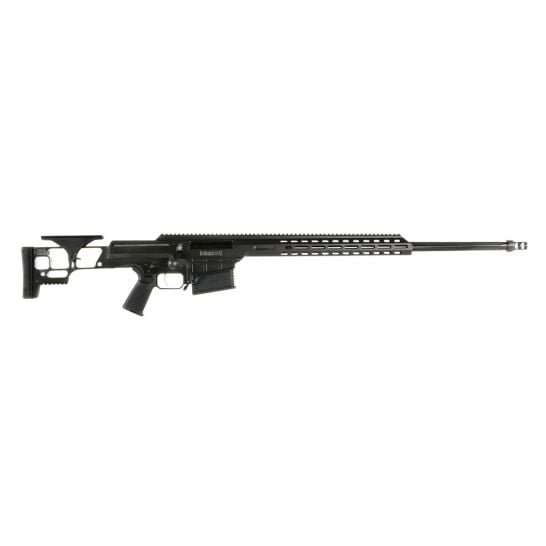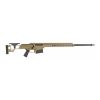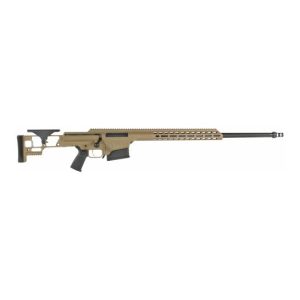Barrett MRAD SMR 6.5 Creedmoor Bolt Action Rifle Fixed Stock 24″, Black – 18520 For Sale
$4,385.00
The Barrett MRAD SMR 6.5 Creedmoor Bolt Action Rifle (model 18520) is a specialized firearm designed for precision and performance in single caliber missions. Unlike the standard MRAD, the SMR model features a factory-set caliber that negates the need for interchangeable barrels, enhancing accuracy and reliability with its free-floating barrel secured by a standard barrel nut. The rifle’s fixed, non-folding stock is crafted for comfort and precision, featuring a vertically adjustable cheek piece and spacers for personalized adjustments in length of pull. These modifications result in a streamlined, lightweight design, reducing weight by nearly 2 ½ pounds and shortening the overall length by an inch compared to the standard MRAD. The Barrett MRAD SMR 6.5 Creedmoor exemplifies a refined blend of sleek aesthetics and meticulous engineering, offering a superior tool for precision shooting.
Can civilians buy Barrett-Mrad?
Yes, civilians in the United States can purchase the Barrett MRAD, as it is available on the civilian market. However, buyers must comply with federal, state, and local regulations regarding firearm purchases, including background checks and age restrictions. Availability may vary depending on the jurisdiction and any specific laws or restrictions in place in your area.
What is MRAD smr?
MRAD SMR refers to the SMR (Semi-Automatic Sniper Rifle) variant of a weapon platform often used in military contexts. MRAD stands for Multi-Role Adaptive Design, which is designed by Barrett Firearms Manufacturing. It is known for its modularity, allowing it to be adapted for different calibers and roles. The SMR variant is specifically tailored for sniper operations, providing long-range accuracy and reliability.
How far can the Barrett-Mrad shoot?
The Barrett MRAD (Multi-Role Adaptive Design) sniper rifle is capable of engaging targets at long distances, often cited with an effective range of approximately 1,500 to 2,000 meters (about 1,640 to 2,187 yards), depending on the specific ammunition used and environmental conditions.
Is the MRAD a good rifle?
The MRAD (Multi-Role Adaptive Design) rifle by Barrett is generally regarded as a high-quality firearm and is appreciated for several reasons:
1. **Modularity**: The rifle is praised for its modular design, allowing users to change calibers and configurations relatively easily, which is beneficial for different missions or shooting requirements.
2. **Accuracy**: It is known for its precision and reliability, making it a popular choice among military and law enforcement agencies, as well as civilian marksmen.
3. **Build Quality**: Barrett is known for its durable construction and the MRAD is no exception, using high-quality materials to ensure longevity and performance under harsh conditions.
4. **Customization**: The MRAD offers a range of customization options, from barrel lengths to accessories, supporting various operational needs.
While it is generally well-regarded, the rifle’s suitability would depend on specific user needs, experiences, and preferences. It is also a premium product, which comes with a higher price tag compared to many other rifles.
Are Barrett rifles worth the money?
Whether Barrett rifles are worth the money depends on your specific needs and preferences. Here are some factors to consider:
1. **Quality and Performance:** Barrett rifles are known for their high-quality construction, durability, and accuracy, particularly in long-range shooting scenarios.
2. **Purpose:** If you need a rifle for extreme long-range shooting or in professional settings like military or law enforcement, Barrett rifles might justify the investment.
3. **Cost:** Barrett rifles are generally expensive, which may not be justifiable for casual shooters or for uses like hunting where less costly alternatives may suffice.
4. **Resale Value:** High-end firearms like Barrett rifles often maintain their value, which can be a consideration if you plan to sell or trade the rifle in the future.
5. **Enthusiast Appeal:** For firearm enthusiasts and collectors, owning a Barrett can be a matter of prestige and passion, adding subjective value beyond functional considerations.
Evaluate these points in the context of your budget and intended use to determine if a Barrett rifle is worth the investment for you.
Are 50 cals legal in the US?
Yes, .50 caliber rifles are generally legal to own in the United States, but regulations can vary by state. Some states have specific restrictions or requirements for owning them, such as California, where sales of .50 BMG rifles are prohibited. It’s important to check the specific laws and regulations in your state to ensure compliance.
What does SMR stand for rifle?
SMR stands for “Special Mission Rifle.”
How many inches is a MRAD at 100 yards?
A milliradian (MRAD) is an angular measurement that is widely used in long-range shooting. At 100 yards, 1 MRAD is equal to approximately 3.6 inches.
Who uses Barrett Mrad?
Barrett MRAD (Multi-Role Adaptive Design) rifles are typically used by military and law enforcement agencies, as well as some civilian long-range shooting enthusiasts. The versatility and precision of the MRAD make it suitable for various applications, including tactical operations, competitive shooting, and precision marksmanship.
What sniper did Chris Kyle use?
Chris Kyle, the former Navy SEAL sniper, primarily used the McMillan TAC-338 sniper rifle during his deployments. Additionally, he also used the MK 12 Special Purpose Rifle and the Barrett M82A1 .50 caliber rifle.
What round do military snipers use?
Military snipers commonly use the 7.62×51mm NATO round, the .300 Winchester Magnum, and the .338 Lapua Magnum. The choice of round often depends on the specific mission, engagement distances, and the type of sniper rifle being used.
Is 300 PRC better than 338 Lapua?
The question of whether the 300 PRC (Precision Rifle Cartridge) is better than the 338 Lapua Magnum depends on the intended use and context. Here are some points of comparison:
1. **Ballistics and Performance**:
– The 338 Lapua Magnum typically offers greater energy and is better suited for longer ranges, often exceeding 1500 yards, making it popular for extreme long-range shooting.
– The 300 PRC provides outstanding ballistic performance, particularly at long ranges up to 1500 yards, with flatter trajectories and reduced wind drift compared to many other calibers, but it generally carries less energy than the 338 Lapua.
2. **Recoil**:
– The 300 PRC generally has less recoil than the 338 Lapua, which can be a significant factor for shooters looking for more comfort and faster follow-up shots.
3. **Availability and Cost**:
– Ammo and rifle availability can differ based on region, but typically 338 Lapua is more expensive for both ammunition and rifles, while the 300 PRC can be more affordable.
4. **Applications**:
– The 338 Lapua is favored by military and law enforcement snipers for its stopping power at extreme ranges.
– The 300 PRC is a favorite among hunters and competitive long-range shooters looking for a balance of performance and manageability.
5. **Rifle and Land Management**:
– The 300 PRC can often be used in platforms with a standard long-action rifle, whereas the 338 Lapua usually necessitates a specific action, sometimes with associated costs and limitations.
Each cartridge has its strengths and ideal scenarios. Determining which is “better” depends on your specific needs related to shooting distance, intended targets, recoil tolerance, and budget.
Can civilians own military grade weapons?
The ownership of military-grade weapons by civilians is heavily regulated and varies significantly by country. In the United States, for example, civilians generally cannot own fully automatic firearms, such as machine guns, unless they were manufactured before the enactment of the Firearm Owners Protection Act in 1986 and are registered under the National Firearms Act. Even then, they are subject to strict regulations, background checks, and substantial taxes.
Other military-grade equipment, such as explosives, grenades, and rocket launchers, are typically completely prohibited for civilian ownership.
In other countries, the laws are generally more restrictive, with many nations prohibiting civilian ownership of military-grade weapons entirely. Always consult specific national and local laws to understand the precise regulations that apply.
Who can buy a ghost gun?
A “ghost gun” refers to a firearm that is privately made without a serial number, often from kits or 3D-printed parts. The regulations around who can buy or produce these firearms vary by jurisdiction. In the United States, federal law allows individuals who are legally permitted to own firearms to manufacture their own guns for personal use without a license, as long as the firearm is not sold or transferred. However, recent regulations from the Bureau of Alcohol, Tobacco, Firearms and Explosives (ATF) have begun enforcing stricter controls, including the requirement for parts kits to include serial numbers. State laws may impose additional restrictions, with some states outright banning or heavily regulating ghost guns. It’s important to check local laws to understand the specific regulations in any given area.
What is the range of the Barrett Mrad sniper rifle?
The Barrett MRAD sniper rifle has an effective range of approximately 1,500 to 2,000 meters, depending on the specific configuration and ammunition used.
| Product Line | MRAD SMR |
|---|---|
| Action | Bolt Action Repeater |
| Twist | 1 |
| Overall Length | 46.5" |
| Sights | Optic Ready |
Be the first to review “Barrett MRAD SMR 6.5 Creedmoor Bolt Action Rifle Fixed Stock 24″, Black – 18520” Cancel reply
Related products
Barrett MRAD SMR 6.5 Creedmoor
Barrett MRAD SMR 6.5 Creedmoor Bolt Action Rifle, 24" Barrel, Flat Dark Earth – 18521



Reviews
There are no reviews yet.